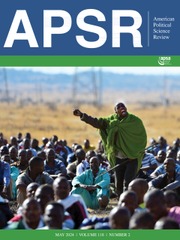Crossref Citations
This article has been cited by the following publications. This list is generated based on data provided by
Crossref.
Powell, G. Bingham
1987.
The Logic of Multiparty Systems.
Vol. 17,
Issue. ,
p.
173.
Strom, Kaare
Browne, Eric C.
Frendreis, John P.
and
Glieber, Dennis W.
1988.
Contending Models of Cabinet Stability.
American Political Science Review,
Vol. 82,
Issue. 3,
p.
923.
Grofman, Bernard
1989.
The Comparative Analysis of Coalition Formation and Duration: Distinguishing Between-Country and Within-Country Effect.
British Journal of Political Science,
Vol. 19,
Issue. 2,
p.
291.
Coleman, Stephen
1993.
Cycles and chaos in political party voting—a research note.
The Journal of Mathematical Sociology,
Vol. 18,
Issue. 1,
p.
47.
Coleman, Stephen
1995.
Dynamics in the fragmentation of political party systems.
Quality & Quantity,
Vol. 29,
Issue. 2,
p.
141.
Hazan, Reuven Y.
1995.
Center Parties and Systemic Polarization.
Journal of Theoretical Politics,
Vol. 7,
Issue. 4,
p.
421.
Norpoth, Helmut
1996.
Of Time and Candidates.
American Politics Quarterly,
Vol. 24,
Issue. 4,
p.
443.
Lin, Tse-Min
and
Guillén, Montserrat
1998.
The Rising Hazards of Party Incumbency: A Discrete Renewal Analysis.
Political Analysis,
Vol. 7,
Issue. ,
p.
31.
Norpoth, Helmut
2004.
From Primary to General Election: A Forecast of the Presidential Vote.
PS: Political Science & Politics,
Vol. 37,
Issue. 4,
p.
737.
Diskin, Abraham
Diskin, Hanna
and
Hazan, Reuven Y.
2005.
Why Democracies Collapse: The Reasons for Democratic Failure and Success.
International Political Science Review,
Vol. 26,
Issue. 3,
p.
291.
Williams, Leighton Vaughan
2005.
Information Efficiency in Financial and Betting Markets.
p.
193.
Norpoth, Helmut
and
Sidman, Andrew H.
2007.
Mission Accomplished: The Wartime Election of 2004.
Political Behavior,
Vol. 29,
Issue. 2,
p.
175.
Clemente, Luis F.
2009.
Apocalypse Not Now? The Argentine Party System after the 2001-2002 Crisis.
SSRN Electronic Journal,
Merrill, Samuel
Grofman, Bernard
and
Brunell, Thomas L.
2011.
Do British Party Politics Exhibit Cycles?.
British Journal of Political Science,
Vol. 41,
Issue. 1,
p.
33.
NORPOTH, HELMUT
2012.
To Change or Not to Change Horses: The World War II Elections.
Presidential Studies Quarterly,
Vol. 42,
Issue. 2,
p.
324.
Whitford, Andrew B.
2013.
Dynamics of partisan representation the American south, 1898–2010.
Quality & Quantity,
Vol. 47,
Issue. 3,
p.
1531.
Johnson, Jay R.
and
Wing, Simon
2018.
Machine Learning Techniques for Space Weather.
p.
45.
Nelson, Arthur B
2020.
Deterrence in sequential contests: An experimental study.
Journal of Behavioral and Experimental Economics,
Vol. 86,
Issue. ,
p.
101541.
Viola, Roberta
Drummond, Guilherme
Veloso, Adriano
and
Zuardi, Mauricio
2022.
A data-centric approach for predicting individual outcomes in a multi-party legislative system.
p.
01.
Chen, Jinghui
Mizuno, Takayuki
and
Doi, Shohei
2024.
Analyzing political party positions through multi-language twitter text embeddings.
Frontiers in Big Data,
Vol. 7,
Issue. ,


Comments
No Comments have been published for this article.